1. International Diabetes Federation. IDF Diabetes Atlas. 10th ed. Brussels: International Diabetes Federation;2021.
2. Korea Disease Control and Prevention Agency. Korea Health Statistics 2021: Korea National Health and Nutrition Examination Survey (KNHANES VIII-3). Cheongju: Korea Disease Control and Prevention Agency;2022.
3. Funnell MM, Anderson RM. Empowerment and self-management of diabetes. Clin Diabetes. 2004; 22:123–127.
4. UK Prospective Diabetes Study (UKPDS) Group. Intensive blood-glucose control with sulphonylureas or insulin compared with conventional treatment and risk of complications in patients with type 2 diabetes (UKPDS 33). Lancet. 1998; 352:837–853. PMID:
9742976.
5. Korean Diabetes Association: Clinical Practice Guidelines for Diabetes. 8th ed. Seoul: Korean Diabetes Association;2023.
6. Kim Y, Cho E. Lifestyle factors related to glucose control for diabetes management strategies: Nested case control design using KNHANES data. J Korea Converg Soc. 2019; 10:501–510.
7. Lim S, Bae JH, Kwon HS, Nauck MA. COVID-19 and diabetes mellitus: from pathophysiology to clinical management. Nat Rev Endocrinol. 2021; 17:11–30. PMID:
33188364.
8. Williamson EJ, Walker AJ, Bhaskaran K, Bacon S, Bates C, Morton CE, Curtis HJ, Mehrkar A, Evans D, Inglesby P, et al. Factors associated with COVID-19-related death using OpenSAFELY. Nature. 2020; 584:430–436. PMID:
32640463.
9. Barron E, Bakhai C, Kar P, Weaver A, Bradley D, Ismail H, Knighton P, Holman N, Khunti K, Sattar N, et al. Associations of type 1 and type 2 diabetes with COVID-19-related mortality in England: a whole-population study. Lancet Diabetes Endocrinol. 2020; 8:813–822. PMID:
32798472.
10. Kirkpatrick CF, Bolick JP, Kris-Etherton PM, Sikand G, Aspry KE, Soffer DE, Willard KE, Maki KC. Review of current evidence and clinical recommendations on the effects of low-carbohydrate and very-low-carbohydrate (including ketogenic) diets for the management of body weight and other cardiometabolic risk factors: a scientific statement from the National Lipid Association Nutrition and Lifestyle Task Force. J Clin Lipidol. 2019; 13:689–711.e1. PMID:
31611148.
11. Schwingshackl L, Chaimani A, Hoffmann G, Schwedhelm C, Boeing H. A network meta-analysis on the comparative efficacy of different dietary approaches on glycaemic control in patients with type 2 diabetes mellitus. Eur J Epidemiol. 2018; 33:157–170. PMID:
29302846.
12. Meng Y, Bai H, Wang S, Li Z, Wang Q, Chen L. Efficacy of low carbohydrate diet for type 2 diabetes mellitus management: a systematic review and meta-analysis of randomized controlled trials. Diabetes Res Clin Pract. 2017; 131:124–131. PMID:
28750216.
13. Evert AB, Dennison M, Gardner CD, Garvey WT, Lau KH, MacLeod J, Mitri J, Pereira RF, Rawlings K, Robinson S, et al. Nutrition therapy for adults with diabetes or prediabetes: a consensus report. Diabetes Care. 2019; 42:731–754. PMID:
31000505.
14. Ministry of Health and Welfare, The Korean Nutrition Society. Dietary Reference Intakes for Koreans 2020. Sejong: Ministry of Health and Welfare;2020.
15. Oh K, Kim Y, Kweon S, Kim S, Yun S, Park S, Lee YK, Kim Y, Park O, Jeong EK. Korea National Health and Nutrition Examination Survey, 20th anniversary: accomplishments and future directions. Epidemiol Health. 2021; 43:e2021025. PMID:
33872484.
16. Lee CK. Factors influencing glycemic control among type 2 diabetes mellitus patients: the seventh Korea National Health and Nutrition Examination Survey (2016–2018). Health & Nursing. 2016-2018; 33:15–26.
17. Jung KM, Lee SJ, Park ES, Park YJ, Kim SG, Choi DS. Self-care and related factors in young and middle adulthood patients with type 2 diabetes. J Korean Diabetes. 2015; 16:65–77.
18. Jeong DJ, Lee JH, Yoon EJ. Study on nutrition, dietary and health status of middle-aged Korean men according to sedentary hours: based on the 2019 Korea National Health and Nutrition Examination Survey. J Nutr Health. 2022; 55:359–375.
19. Park J, Yeo Y, Yoo JH. Dietary intake and nutritional status in young and middle-aged adults according to the meal frequency from the Korea National Health and Nutritional Survey. Korean J Fam Med. 2022; 43:319–326. PMID:
36168904.
20. Park H, Shin D, Lee KW. Association of main meal frequency and skipping with metabolic syndrome in Korean adults: a cross-sectional study. Nutr J. 2023; 22:24. PMID:
37165359.
21. Paoli A, Tinsley G, Bianco A, Moro T. The influence of meal frequency and timing on health in humans: the role of fasting. Nutrients. 2019; 11:719. PMID:
30925707.
22. Kim HR, Ryu DH, Lee CW, Lee J, Jeong YJ, Kim HS. Analysis of dietary intake profiles according to eating alone behavior: the eighth Korea National Health and Nutrition Examination Survey. Korean J Fam Pract. 2023; 13:112–119.
23. Kwon JS, Kim WJ, Han YH, Kim HJ, Shin SY, Choi KH, Jun JH, Shim MS, Kim JY. Association between diabetes education status and clinical outcomes of patients with diabetes mellitus: analysis of the fifth Korea National Health and Nutrition Examination Survey (KNHANES V). J Korean Diabetes. 2014; 15:236–243.
24. Powers MA, Bardsley JK, Cypress M, Funnell MM, Harms D, Hess-Fischl A, Hooks B, Isaacs D, Mandel ED, Maryniuk MD, et al. Diabetes self-management education and support in adults with type 2 diabetes: a consensus report of the American Diabetes Association, the Association of Diabetes Care & Education Specialists, the Academy of Nutrition and Dietetics, the American Academy of Family Physicians, the American Academy of PAs, the American Association of Nurse Practitioners, and the American Pharmacists Association. Diabetes Care. 2020; 43:1636–1649. PMID:
32513817.
25. Lee SJ, Han MA, Park J, Ryu SY. Utilization of nutrition labels and related factors among patients with diabetes in Korea. Nutr Res Pract. 2023; 17:297–306. PMID:
37009140.
26. Razaz JM, Rahmani J, Varkaneh HK, Thompson J, Clark C, Abdulazeem HM. The health effects of medical nutrition therapy by dietitians in patients with diabetes: a systematic review and meta-analysis: nutrition therapy and diabetes. Prim Care Diabetes. 2019; 13:399–408. PMID:
31186171.
27. Cho Y, Lee M, Jang H, Rha M, Kim J, Park Y, et al. The clinical and cost effectiveness of medical nutrition therapy for patients with type 2 diabetes mellitus. Korean J Nutr. 2008; 41:147–155.
28. Lean ME, Leslie WS, Barnes AC, Brosnahan N, Thom G, McCombie L, Peters C, Zhyzhneuskaya S, Al-Mrabeh A, Hollingsworth KG, et al. Primary care-led weight management for remission of type 2 diabetes (DiRECT): an open-label, cluster-randomised trial. Lancet. 2018; 391:541–551. PMID:
29221645.
29. Davies MJ, Aroda VR, Collins BS, Gabbay RA, Green J, Maruthur NM, Rosas SE, Del Prato S, Mathieu C, Mingrone G, et al. Management of hyperglycemia in type 2 diabetes, 2022. a consensus report by the American Diabetes Association (ADA) and the European Association for the Study of Diabetes (EASD). Diabetes Care. 2022; 45:2753–2786. PMID:
36148880.
30. Delevatti RS, Bracht CG, Lisboa SD, Costa RR, Marson EC, Netto N, Kruel LF. The role of aerobic training variables progression on glycemic control of patients with type 2 diabetes: a systematic review with meta-analysis. Sports Med Open. 2019; 5:22. PMID:
31175522.
31. Pan B, Ge L, Xun YQ, Chen YJ, Gao CY, Han X, Zuo LQ, Shan HQ, Yang KH, Ding GW, et al. Exercise training modalities in patients with type 2 diabetes mellitus: a systematic review and network meta-analysis. Int J Behav Nutr Phys Act. 2018; 15:72. PMID:
30045740.
32. Borror A, Zieff G, Battaglini C, Stoner L. The effects of postprandial exercise on glucose control in individuals with type 2 diabetes: a systematic review. Sports Med. 2018; 48:1479–1491. PMID:
29396781.
33. Park JH, Lim SG, Yim ES, Kim YD, Jeong UJ. Factors associated with poor glycemic control among patients with type 2 diabetes mellitus: the fifth Korea National Health and Nutrition Examination Survey (2010–2012). Health Policy Manag. 2016; 26:125–134.
34. Jung CH, Son JW, Kang S, Kim WJ, Kim HS, Kim HS, Seo M, Shin HJ, Lee SS, Jeong SJ, et al. Diabetes fact sheets in Korea, 2020: an appraisal of current status. Diabetes Metab J. 2021; 45:1–10. PMID:
33434426.
35. Bae JH, Han KD, Ko SH, Yang YS, Choi JH, Choi KM, Kwon HS, Won KC. Diabetes fact sheet in Korea 2021. Diabetes Metab J. 2022; 46:417–426. PMID:
35656565.
36. Yoon SH, Lee JH, Oh KW. National Health Statistics Plus. Current Status of People’s Dietary Habits in Korea. Cheongju: Korea Disease Control and Prevention Agency;2021.
37. Sallé A, Ryan M, Ritz P. Underreporting of food intake in obese diabetic and nondiabetic patients. Diabetes Care. 2006; 29:2726–2727. PMID:
17130213.
38. Park K. Trends in adherence to dietary recommendations among Korean type 2 diabetes mellitus patients. Nutr Res Pract. 2015; 9:658–666. PMID:
26634056.
39. Jayedi A, Zeraattalab-Motlagh S, Jabbarzadeh B, Hosseini Y, Jibril AT, Shahinfar H, Mirrafiei A, Hosseini F, Bidar SS. Dose-dependent effect of carbohydrate restriction for type 2 diabetes management: a systematic review and dose-response meta-analysis of randomized controlled trials. Am J Clin Nutr. 2022; 116:40–56. PMID:
35537861.
40. Lee YJ, Song S, Song Y. High-carbohydrate diets and food patterns and their associations with metabolic disease in the Korean population. Yonsei Med J. 2018; 59:834–842. PMID:
30091316.
41. Draznin B, Aroda VR, Bakris G, Benson G, et al. 5. Facilitating behavior change and well-being to improve health outcomes: standards of medical care in diabetes-2022. Diabetes Care. 2022; 45:S60–S82. PMID:
34964866.
42. Hill-Briggs F, Adler NE, Berkowitz SA, Chin MH, Gary-Webb TL, Navas-Acien A, Thornton PL, Haire-Joshu D. Social determinants of health and diabetes: a scientific review. Diabetes Care. 2020; 44:258–279. PMID:
33139407.
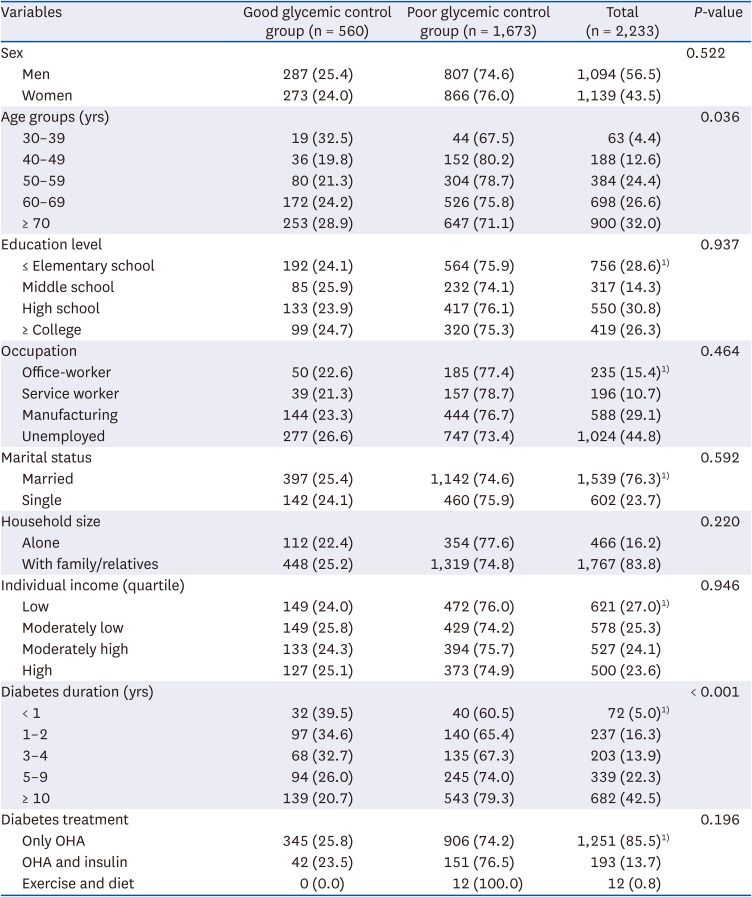
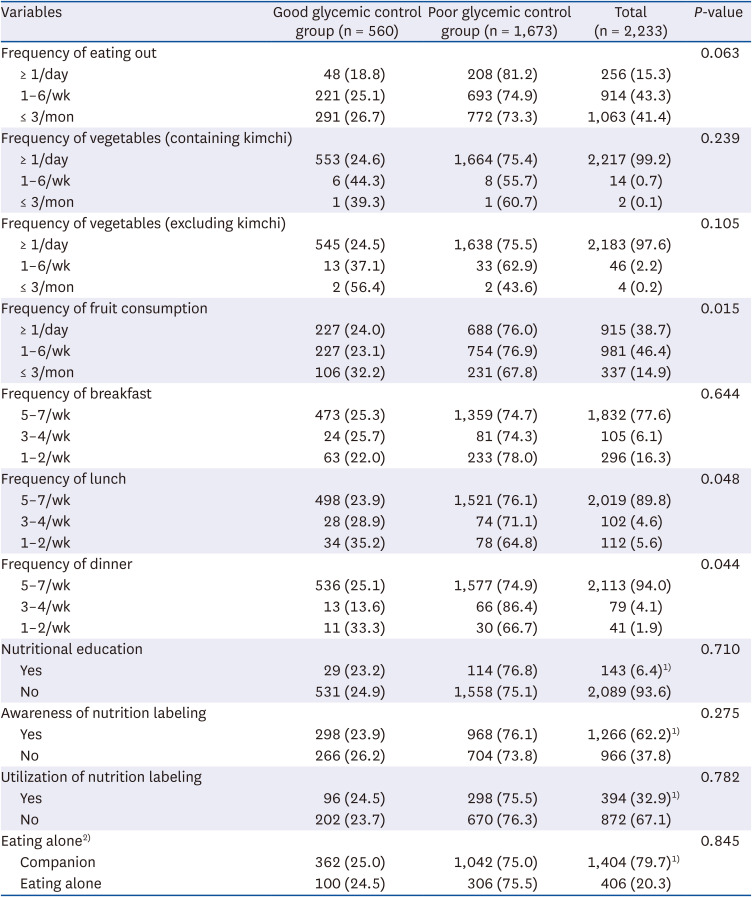
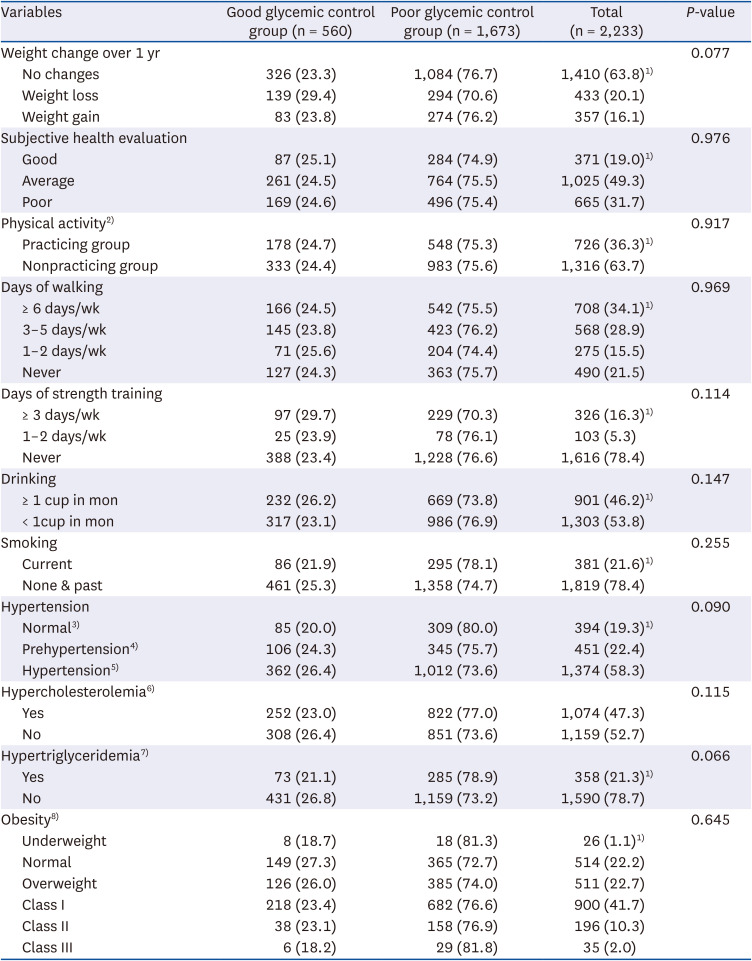
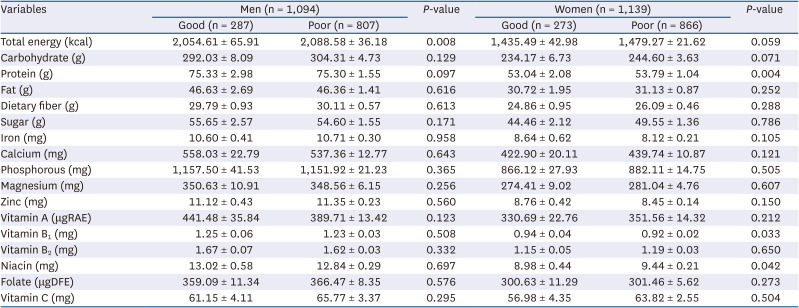

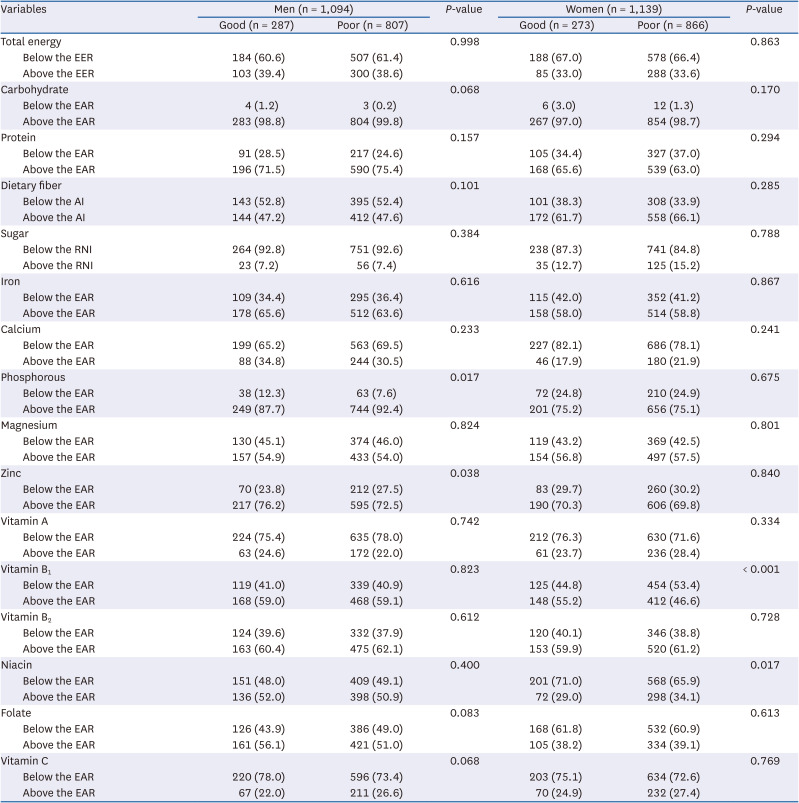





 PDF
PDF Citation
Citation Print
Print



 XML Download
XML Download